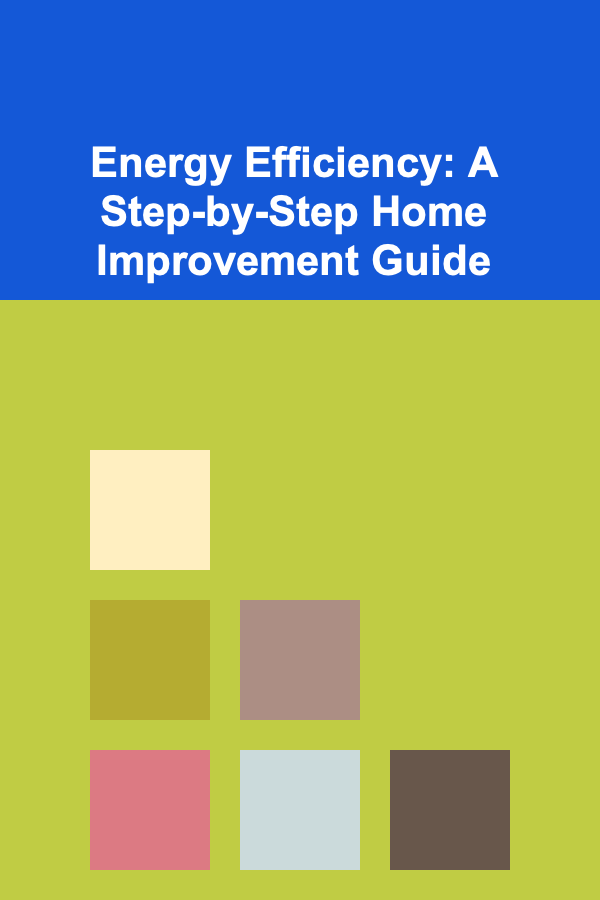
Energy Efficiency: A Step-by-Step Home Improvement Guide
ebook include PDF & Audio bundle (Micro Guide)
$12.99$9.99
Limited Time Offer! Order within the next:

Energy efficiency is not only crucial for reducing environmental impact but also for cutting down on utility bills and improving the comfort of your home. Whether you're looking to make small adjustments or undertake larger home improvement projects, becoming more energy-efficient is an investment in your home's future and the planet's. This guide will walk you through a step-by-step approach to improve the energy efficiency of your home, covering simple actions as well as more complex upgrades.
Understanding Energy Efficiency
Before diving into home improvements, it's important to understand what energy efficiency means. Energy efficiency involves using less energy to perform the same task or achieve the same result. In a home, this typically translates into using less energy for heating, cooling, lighting, and appliances without sacrificing comfort or convenience.
Improving energy efficiency can help lower energy consumption, which reduces greenhouse gas emissions from power plants and helps preserve natural resources. It can also lower your monthly utility bills, making it a financially sound decision in the long run.
Step 1: Conduct an Energy Audit
An energy audit is the first step in improving the energy efficiency of your home. A professional energy auditor can assess your home and identify areas where energy is being wasted. However, many utilities offer free or low-cost audits, and there are DIY audits you can do to get a general sense of your home's energy performance.
DIY Energy Audit Checklist
- Inspect insulation: Look in your attic, walls, and floors for areas where insulation is inadequate or damaged.
- Check windows and doors: Look for drafts around windows and doors and check if weatherstripping or caulking is missing.
- Examine appliances: Make sure that your appliances are energy-efficient models. Older appliances may consume more energy than necessary.
- Assess lighting: Take note of all the incandescent bulbs in your home. Replacing them with LEDs can drastically reduce energy consumption.
- Review heating and cooling systems: Check if your furnace or air conditioning unit is operating efficiently or needs maintenance.
An energy audit will provide you with valuable information on where to prioritize improvements.
Step 2: Insulate Your Home
One of the most effective ways to increase energy efficiency is by ensuring your home is well-insulated. Insulation acts as a barrier to heat flow, helping to keep your home warm in the winter and cool in the summer. The better your home's insulation, the less energy you'll need to heat or cool it.
Types of Insulation
- Attic Insulation: Insulating the attic is crucial, as it's the most common place for heat loss. Fiberglass batt insulation, spray foam, or cellulose are all excellent options. The recommended R-value for attic insulation ranges between R-30 and R-60, depending on your climate.
- Wall Insulation: Insulating walls can be more complicated, especially in existing homes. Options include adding blown-in insulation or installing rigid foam boards inside the walls. This is a bigger job but can make a significant difference in energy costs.
- Floor Insulation: For homes with unheated basements or crawlspaces, insulating the floors can reduce heat loss. Foam board insulation or fiberglass batt insulation can be installed under floors.
- Windows and Doors: If you have older windows or doors, replacing them with energy-efficient models can significantly reduce heat loss. Alternatively, you can use weatherstripping, caulk, or thermal curtains to improve energy efficiency without replacing windows entirely.
Sealing Air Leaks
In addition to insulation, it's important to seal air leaks around windows, doors, and other openings. This can be done with weatherstripping, caulking, or foam sealants. Pay special attention to areas like:
- Around windows and doors
- Electrical outlets
- Around vents and pipes
- Attic hatches and chimneys
These gaps allow cold air to enter in winter and warm air to escape in summer, causing your heating and cooling systems to work harder.
Step 3: Upgrade Your Heating and Cooling Systems
Heating and cooling systems account for a large portion of a home's energy use. If your furnace, air conditioner, or heat pump is old or inefficient, upgrading to a more energy-efficient system can yield significant savings over time.
Furnace and Boiler Upgrades
- High-Efficiency Furnace: Modern, high-efficiency furnaces operate at over 90% efficiency, meaning more heat is delivered into your home instead of being lost in the exhaust gases. Look for a furnace with an AFUE (Annual Fuel Utilization Efficiency) rating of at least 90%.
- Smart Thermostats: Installing a programmable thermostat or smart thermostat can help optimize your home's temperature by automatically adjusting heating and cooling based on your schedule. This reduces the need for heating or cooling when you're not home and can save you up to 10% on your energy bills.
- Air Sealing: Before upgrading your heating system, make sure the ductwork is sealed. Leaky ducts can account for significant energy loss.
Air Conditioning and Heat Pumps
- Energy-Efficient Air Conditioners: When replacing your air conditioner, look for a high SEER (Seasonal Energy Efficiency Ratio) rating. The higher the SEER rating, the more efficient the unit.
- Ductless Mini-Split Systems: If your home lacks ductwork, a ductless mini-split system can be a more energy-efficient option for cooling specific rooms or zones.
- Heat Pumps: Air-source heat pumps can provide both heating and cooling, offering an energy-efficient alternative to traditional heating and air conditioning systems. Modern heat pumps can operate efficiently in a wide range of temperatures.
Step 4: Upgrade to Energy-Efficient Appliances
Appliances use a significant amount of energy in the home. Upgrading to energy-efficient models can lead to significant savings on your electricity bill.
Kitchen Appliances
- Energy-Efficient Refrigerators: Modern refrigerators use up to 50% less energy than older models. Look for ENERGY STAR-rated refrigerators, which meet strict energy-efficiency guidelines.
- Dishwashers: Dishwashers that are ENERGY STAR-rated consume less water and energy. Also, using your dishwasher only when full can further reduce energy use.
- Ovens and Stoves: Induction cooktops and convection ovens are more efficient than traditional electric or gas models because they heat food faster and reduce wasted energy.
Laundry Appliances
- High-Efficiency Washing Machines: These machines use less water and energy compared to traditional washing machines. Choose models with the ENERGY STAR label for the best performance.
- Dryers: Dryers are one of the biggest energy hogs in the home. To reduce energy use, opt for a high-efficiency dryer with moisture-sensing technology, which prevents over-drying and reduces energy consumption.
Step 5: Switch to Energy-Efficient Lighting
Lighting is one of the easiest and most affordable areas to improve energy efficiency. Traditional incandescent bulbs waste a lot of energy in the form of heat, whereas modern bulbs are much more efficient.
LED Lighting
Switching from incandescent or CFL bulbs to LED (Light Emitting Diode) bulbs is one of the best ways to reduce your energy consumption. LEDs use up to 75% less energy than incandescent bulbs and last significantly longer, making them a smart long-term investment. Replace all light bulbs in your home with LEDs to reduce lighting costs.
Smart Lighting
Consider investing in smart lighting systems that allow you to control your lights remotely or through automation. Smart bulbs can be dimmed, turned on or off based on your schedule, and some models can even change color to suit your mood or activities, all while using less energy.
Step 6: Utilize Renewable Energy Sources
If you are looking to make a more substantial commitment to energy efficiency, consider integrating renewable energy sources into your home. While it may require a larger upfront investment, renewable energy can significantly reduce your reliance on fossil fuels and lower your energy bills in the long term.
Solar Panels
Solar energy is one of the most popular renewable energy sources for homeowners. Installing solar panels on your roof can generate clean electricity, which can power your home or be sold back to the grid. Depending on your location and the size of your system, solar panels can reduce your monthly electricity costs and provide a long-term return on investment.
Wind Energy
If you live in an area with consistent wind, a small residential wind turbine may be an option to supplement your home's energy needs. Wind energy works similarly to solar in that it can either be used directly or fed into the grid.
Solar Water Heating
Solar water heaters use sunlight to heat your water, reducing the need for traditional electric or gas water heaters. These systems can be especially beneficial in sunny climates where heating water is a significant portion of your energy use.
Step 7: Adopt Water Conservation Practices
Conserving water not only saves money but also reduces the energy needed to pump, heat, and treat water. By making water-efficient changes in your home, you can reduce both water and energy consumption.
Water-Efficient Fixtures
- Low-Flow Showerheads and Faucets: Installing low-flow showerheads and faucet aerators can reduce water use by up to 50%, which also lowers the energy used to heat the water.
- Energy-Efficient Water Heaters: Consider upgrading to a tankless or heat pump water heater, which provides hot water on demand and uses less energy than traditional water heaters.
Conclusion
Improving the energy efficiency of your home is a multifaceted approach that can lead to significant long-term benefits. From small changes like upgrading lighting and sealing air leaks to larger projects such as installing insulation and renewable energy systems, every step you take will contribute to lowering energy consumption, reducing costs, and improving your home's environmental footprint.
By following this step-by-step guide, you can make informed decisions, reduce your energy usage, and create a more comfortable, sustainable home. Whether you start small or tackle bigger projects, the rewards of energy efficiency will pay off both financially and environmentally.

How to Create a Cozy Living Room Atmosphere for Staging
Read More
The Compliance Officer's Playbook: Best Practices for Ensuring Organizational Integrity
Read More
What Are the Best Organizational Apps for Busy Families?
Read More
How To Master Coffee Grading and Quality Control
Read More
How to Save Money on Airport Transfers: A Comprehensive Guide
Read More10 Tips for Using a Monthly Budget Tracker to Pay Off Debt
Read MoreOther Products

How to Create a Cozy Living Room Atmosphere for Staging
Read More
The Compliance Officer's Playbook: Best Practices for Ensuring Organizational Integrity
Read More
What Are the Best Organizational Apps for Busy Families?
Read More
How To Master Coffee Grading and Quality Control
Read More